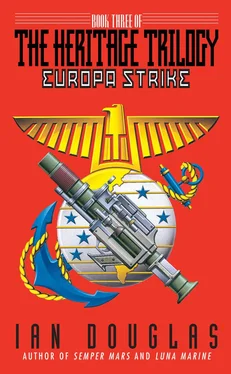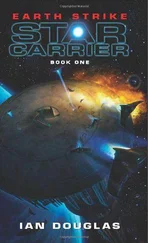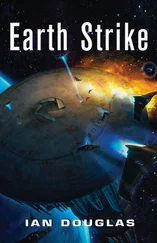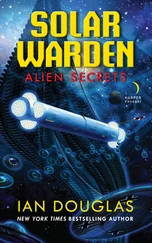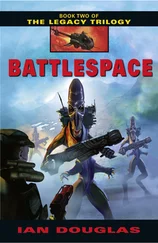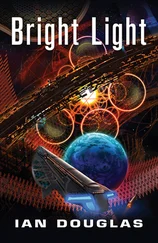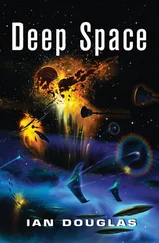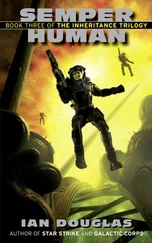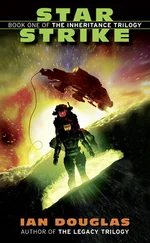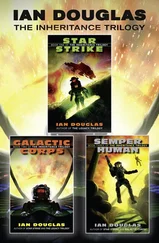That was why Lieutenant Lee was on board with his platoon of twenty-eight space-trained Marines. The JFK would match course and speed with the hostile, disable her if necessary, then close and grapple for the final round. Mitchell was amused that modern tactical thinking was actually looking at the possibility of using Marines to take an enemy ship by storm, something that hadn’t happened since the boarding of the Mayaguez in 1975.
“Well, it’ll be interesting to see Lieutenant Lee here swing across from the yardarms, cutlass and boarding pistol in hand!”
“I’d need more than two hands for that evolution, sir,” the lieutenant replied. “I think we’ll stick to M580s, and hope the bad guys aren’t in the mood for much of a fight when we get there.”
“Doesn’t sound like the fire-eating Marines I know,” Varley said.
“Hey, if it can be done without a firefight…”
“Do you anticipate problems with your mission, Lieutenant?”
“A good officer always anticipates problems, sir. Boarding a hostile spacecraft is at least as hairy as a houseclearing operation—and it’s complicated by being in zero gravity and the possibility of explosive decompression.” He grinned. “Playing with weapons inside a thin-skinned spacecraft isn’t exactly a real bright idea.”
“I imagine the whole question is academic,” Varley said with a shrug. “The Chinese can’t beat the laws of physics. Even accelerating at 2 Gs, they can’t outrun us because we have the metaphorical high ground in the Solar System. They can’t maneuver and accelerate both. When we close and match velocity, they’ll have to surrender…or risk a mass driver round through their drive unit.”
“They must have something in mind,” Lieutenant Zynkowovec said. He was the ship’s third engineering officer. “They know we’re out here, and they know physics as well as we do. They’ve gotta have something up their sleeves.”
“They just don’t know about our secret weapon!” Varley said, laughing. “The U.S. Marines!”
The radio clipped to Mitchell’s collar chirped. Damn. Always when he was sitting down to dinner. “What is it?”
“We are tracking an incoming object, Captain,” the voice of Jackie, the JFK’s AI, said in unhurried tones. “There is a threat to the ship.”
He was already on his feet and jogging for the access corridor that would take him to the ship’s hub, then forward to the bridge. “What threat?”
“The object is small—less than ten kilograms’ mass—but it is on an approach vector with a velocity of five hundred kilometers per second. Range, 15,000 kilometers, closing.”
The calm words chilled. Thirty seconds to impact.
“Why the hell didn’t we see it on radar?”
“The object is quite small, less than three meters long, and appears to exhibit stealth characteristics. Its radar cross-section is less than two centimeters across.”
A stealth missile? They still should have picked up the IR footprint of its exhaust!
“The object has just executed a minor course change,” Jackie continued. “It was unpowered until now. Definitely now on an intercept course…and accelerating.”
“Maneuver!” Mitchell bellowed. If the incoming was changing course…
He was in the access tube now, hand-over-handing rapidly into lower and lower gravity as he raced for the hub. But he knew there wasn’t time to reach the bridge.
He felt the thump, the surge of weight sideways, as the Kennedy’s maneuvering thrusters fired.
Seconds later, something struck the ship. Jeremy Mitchell was slammed against one side of the access tunnel by a savage, sudden acceleration. It felt as though the ship was tumbling, pressing him against the wall of the access tube with centrifugal force.
He heard metal shrieking protest—a screech, followed by a succession of loud pops and bangs, and the shrill whistle of air escaping to vacuum.
Then the entire universe seemed to explode in raw noise rapidly dwindled to vacuum-muffled silence, and the Kennedy’s captain found himself pinwheeling through black and cold and fragment-filled space, dying in a cloud of fast-freezing blood even as he tried to grasp the enormity of what was happening to his ship…and him.
U.S.S. John F. Kennedy
Solar orbit, 4.2 a.u. from Earth
2007 hours Zulu
Two force packages had been accelerated at the Kennedy—or rather, at that area of space the Kennedy would orbit through precisely nineteen days after the Heavenly Lightning fired them. The first, detected at the last possible moment, executed a course change for intercept and almost missed. Kennedy’s sudden maneuver—firing forward thrusters to reduce her orbital velocity—almost caused the Chinese missile to pass across her bows.
But a second course change countered the Kennedy’s move, and the force package struck far forward, ripping through the thin metal shell of the Peaceforcer cruiser’s forward reaction mass tank. The electromagnetic bottle anchoring a pea-sized fragment of antimatter in the hard vacuum of the package’s warhead failed, the antimatter slammed into metal and water, and then a fireball as hot as the surface of the sun blossomed into deadly radiance.
Water flashed into steam and exploded into space. The cruiser, almost 200 meters long, was whip-snapped by the detonation into a sudden and violent spin, tumbling end over end. Two of the hab modules, their coupling and spin mechanisms overstressed by the sudden off-balance acceleration, wrenched partly free, then broke away entirely, hurtling into the night with hundreds of smaller fragments as the great vessel began to tear itself apart.
The second package, homing on the heat and radiation of the first explosion, had more time to correct its intercept vector, and slammed into the Kennedy’s wreckage amidships. The explosion engulfed half the ship, and left only spinning fragments behind.
At its present position, the twin bursts of radiation marking the Kennedy’s destruction would take twenty minutes to reach Jupiter—and twenty-eight to make it across the void to Earth.
12 OCTOBER 2067
In Europa orbit
2007 hours (Zulu)
“Thirty seconds to release,” the voice of the Roosevelt’s skipper, Captain Galtmann, said in Jeff’s ear. “How’re you boys and girls making out over there?”
“Squared away, sir,” Jeff replied. “Ready for drop.” He tried to force some semblance of discipline on his unpleasantly twisting stomach. He hated zero G.
“Happy landings, then. We’ll see you again in six months!”
“Remember the surface radiation,” Colonel Norden’s voice added, rasping. “Get your people under cover stat, until we can give those suits a full checkout in field conditions.”
“Aye, aye, sir,” Jeff replied. “We’ll set a new speed record for cross-country ice-jogging.” Although, damn it, if the suits didn’t work, none of them would live long enough to even reach shelter. The surface of Europa, despite the cold, was hot….
“Keep me posted up here. I’ll be down in two orbits—say, 180 minutes.”
“Roger that. We’ll be waiting, sir.”
Jeff craned his head, trying to see out the tiny porthole beside his seat and get a glimpse of the Roosevelt. His suit, with its cumbersome helmet, and the fact that he was strapped down in the narrow, hard-backed seat, kept him from seeing much of anything. All that was visible through the port was the dead-black of space, and a few scattered stars, plus a little bit of the bug’s framework embracing the pressurized passenger module.
The bug was similar to lobbers and other short-haul transports used by the Marines during various Lunar operations. Intended solely for operation in vacuum, it was completely unstreamlined—a chunky, squared-off bottle shape housing command deck and passenger/cargo spaces, plus spherical fuel tanks and a chemical rocket engine all crammed together inside a webwork of titanium/carbon fiber struts, with six landing legs, powerful external spotlights, and small maneuvering thrusters on flanks and belly. It was an ungainly-looking vehicle, well deserving of the Marines’ pet name for them: bugs. Each was thirty-three meters long, with space aboard—with some creative cramming—for one platoon, in this case the forty-one men and women of Second Platoon, Bravo Company, plus six of the Navy SEALs with the DSV team.
Читать дальше
